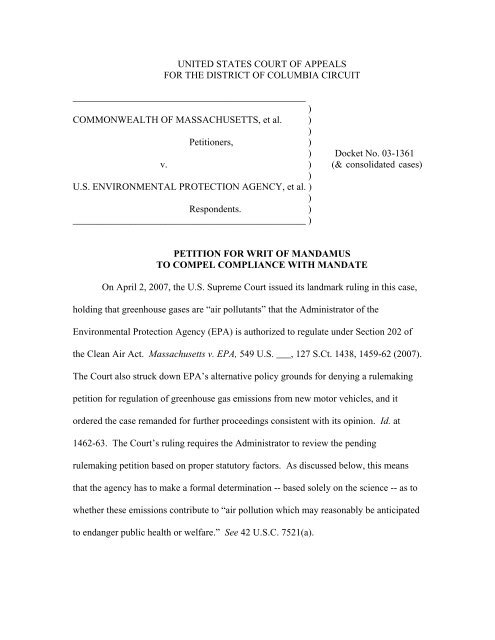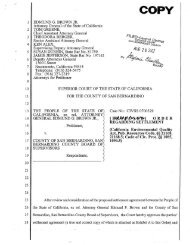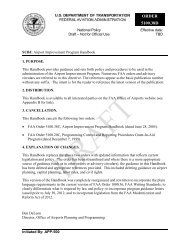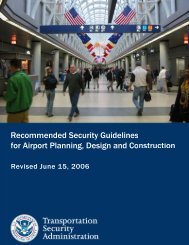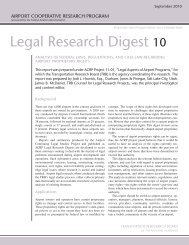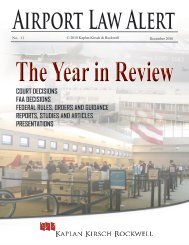petition for writ of mandamus to compel compliance with mandate
petition for writ of mandamus to compel compliance with mandate
petition for writ of mandamus to compel compliance with mandate
You also want an ePaper? Increase the reach of your titles
YUMPU automatically turns print PDFs into web optimized ePapers that Google loves.
and ordering the agency <strong>to</strong> take action consistent <strong>with</strong> the Supreme Court’s decision. Acopy <strong>of</strong> this Court’s <strong>mandate</strong> is attached as Exhibit A.In its opinion, the Supreme Court itself noted that there is little remainingscientific debate about the gravity and cause <strong>of</strong> the looming climate change crisis. Forexample, the Court stated:The harms associated <strong>with</strong> climate change are serious and well recognized. Indeed,the NRC Report itself -- which EPA regards as an “objective and independentassessment <strong>of</strong> the relevant science,” 68 Fed.Reg. 52930 -- identifies a number <strong>of</strong>environmental changes that have already inflicted significant harms, including“the global retreat <strong>of</strong> mountain glaciers, reduction in snow-cover extent, theearlier spring melting <strong>of</strong> rivers and lakes, [and] the accelerated rate <strong>of</strong> rise <strong>of</strong> sealevels during the 20th century relative <strong>to</strong> the past few thousand years ....” NRCReport 16.127 S.Ct. at 1455. See also id. at 1457 (“EPA does not dispute the existence <strong>of</strong> a causalconnection between man-made greenhouse gas emissions and global warming.”).EPA Commitments and Actions After the Supreme Court’s DecisionIn response <strong>to</strong> the Court’s ruling, President Bush on May 14, 2007, announcedthat he had directed the Administra<strong>to</strong>r <strong>to</strong> issue standards <strong>to</strong> reduce emissions <strong>of</strong>greenhouse gases from mo<strong>to</strong>r vehicles under Section 202 <strong>of</strong> the Clean Air Act. 3In apress briefing immediately after the President’s announcement, the Administra<strong>to</strong>rstated:On April 2, 2007, the U.S. Supreme Court decided in Massachusetts versus EPAthat the Clean Air Act provided EPA the statu<strong>to</strong>ry authority <strong>to</strong> regulategreenhouse gas emissions from new vehicles if I determine in my judgment3 Statement <strong>of</strong> President Bush, May 14, 2007, available athttp://www.whitehouse.gov/news/releases/2007/05/20070514-4.html (Attached as Ex. B).The President simultaneously directed EPA <strong>to</strong> issue regulations <strong>for</strong> the content <strong>of</strong> mo<strong>to</strong>rvehicle fuels, <strong>to</strong> reduce the amount <strong>of</strong> carbon dioxide released when those fuels areburned, under Section 211 <strong>of</strong> the Clean Air Act, 42 U.S.C. 7545. The fuel regulationswere not subject <strong>to</strong> this litigation, and relief is sought only <strong>for</strong> the action due underSection 202 regarding mo<strong>to</strong>r vehicle emissions.5
whether such emissions endanger public health and welfare under the Clean AirAct. Today the President has responded <strong>to</strong> the Supreme Court’s landmarkdecision by calling on EPA and our federal partners <strong>to</strong> move <strong>for</strong>ward and take thefirst regula<strong>to</strong>ry step <strong>to</strong> craft a proposal <strong>to</strong> control greenhouse gas emissions fromnew mo<strong>to</strong>r vehicles.* * *[O]ur target <strong>for</strong> a draft proposal will be fall <strong>of</strong> this year. And as part <strong>of</strong> that proposal, we will address the endangerment finding as part <strong>of</strong> the proposal.* * * The proposal – the sequence, we develop a proposed rule-making; then we take public comment on that proposed rule-making, which I said we would – our goalis <strong>to</strong> have a proposal out this fall, fall <strong>of</strong> 2007. Then there would be a notice andcomment; then we then review all <strong>of</strong> those comments, and then make a finaldecision, which would then be issued in the final regulation, which the Presidenthas asked <strong>for</strong> us <strong>to</strong> have it completed by the end <strong>of</strong> 2008. 4By stating that it was moving <strong>for</strong>ward <strong>with</strong> proposed regulations under Section 202(a)(1),EPA acknowledged its view that endangerment was occurring and that any remainingscientific uncertainty on climate change was not so pr<strong>of</strong>ound as <strong>to</strong> preclude the agencyfrom making a judgment on endangerment. This follows because that section“condition[s] the exercise <strong>of</strong> EPA’s authority on its <strong>for</strong>mation <strong>of</strong> a ‘judgment’”concerning the statu<strong>to</strong>ry endangerment standard. 127 S. Ct. at 1462.Throughout the summer and fall, in public statements, in testimony under oath <strong>to</strong>Congressional committees, and in Federal Register notices, the EPA Administra<strong>to</strong>r andhis agency repeatedly reiterated the intention <strong>to</strong> issue an endangerment determination, aswell as proposed standards, by the end <strong>of</strong> 2007. For example, at a hearing on November4 Briefing, May 14, 2007, available athttp://www.whitehouse.gov/news/releases/2007/05/20070514-6.html, (attached as Ex. C).6
8, 2007, be<strong>for</strong>e the House Committee on Oversight and Government Re<strong>for</strong>m, theAdministra<strong>to</strong>r said:Of course, be<strong>for</strong>e the agency, given the Supreme Court decision inMassachusetts v. EPA, the focus is on mobile sources. So we are, as Ihave already mentioned, going <strong>to</strong> be proposing regulating CO2greenhouse gases, from mobile sources by the end <strong>of</strong> this year. 5EPA reaffirmed its end-<strong>of</strong>-the-year schedule in a <strong>for</strong>mal “regula<strong>to</strong>ry plan” published onDecember 10, 2007: “[W]e have established a schedule <strong>to</strong> issue a notice <strong>of</strong> proposedrulemaking by the end <strong>of</strong> 2007 and a final rule by the end <strong>of</strong> Oc<strong>to</strong>ber 2008.” UnifiedAgenda, Environmental Protection Agency, 72 Fed. Reg. 69922, 69934 (Dec. 10, 2007).EPA cited the Supreme Court’s ruling as the legal basis <strong>for</strong> its plan, and it characterizedthat ruling as requiring EPA <strong>to</strong> make an endangerment determination. See id. (“On April2, 2007, the Supreme Court ruled that the EPA must determine, under Section 202(a) <strong>of</strong>the Clean Air Act, whether greenhouse gas emissions (GHG) from new mo<strong>to</strong>r vehiclescause or contribute <strong>to</strong> air pollution that endangers public health or welfare.”).An investigation conducted by the House Committee on Oversight andGovernment Re<strong>for</strong>m has established that, consistent <strong>with</strong> its announced schedule, EPAhad in fact completed its internal process <strong>of</strong> drafting an affirmative endangermentdetermination during fall 2007. Letter from Chairman Henry A. Waxman <strong>to</strong> EPAAdministra<strong>to</strong>r Stephen L. Johnson dated March 12, 2008, at 3-6 (attached as Ex. E). TheHouse investigation concluded that the Administra<strong>to</strong>r personally approved the affirmativedetermination and that, in early December <strong>of</strong> 2007, EPA transmitted a fully-drafted5 Hearing on EPA Approval <strong>of</strong> New Power Plants: Failure <strong>to</strong> Address GlobalWarming, be<strong>for</strong>e the Committee on Oversight and Government Re<strong>for</strong>m, House <strong>of</strong>Representatives, at 57 (Nov. 8, 2007), available at:http://oversight.house.gov/documents/20071115145634.pdf (attached as Ex. D).7
Federal Register notice announcing the affirmative endangerment determination <strong>to</strong> theWhite House Office <strong>of</strong> Management and Budget where it now apparently sits. Id. at 5-6.In addition, the investigation found that EPA had completed an extensive scientificreview document in support <strong>of</strong> the endangerment determination (id., at 3-5), but thatwork regarding the endangerment determination s<strong>to</strong>pped once the proposeddetermination was sent <strong>to</strong> the White House. Id. at 7.Further evidence that the Administra<strong>to</strong>r has in fact completed his scientific reviewand reached his conclusions regarding the adverse effects <strong>of</strong> greenhouse gas emissions isfound in the Federal Register notice published on March 6, 2008, <strong>to</strong> explain theAdministra<strong>to</strong>r’s action under Section 209 <strong>of</strong> the Clean Air Act denying Cali<strong>for</strong>niapermission <strong>to</strong> implement its own greenhouse gas emission standards. 73 Fed. Reg. 12156(March 6, 2008). In this notice, the Administra<strong>to</strong>r endorsed the conclusion <strong>of</strong> theIntergovernmental Panel on Climate Change (IPCC) that global warming “is unequivocaland is now evident from observations <strong>of</strong> increases in global average air and oceantemperatures, widespread melting <strong>of</strong> snow and ice, and rising global sea level.” 73 Fed.Reg. 12165/2, citing IPCC (2007) Summary <strong>for</strong> Policymakers. He also expresslyconcluded that greenhouse gas emissions, including from mo<strong>to</strong>r vehicles, are contributing<strong>to</strong> global warming. Id. at 12165 (“It is widely recognized that greenhouse gases have aclimatic warming effect.”); id. at 12162 (acknowledging the contribution <strong>of</strong> mo<strong>to</strong>rvehicle emissions <strong>to</strong> global greenhouse gas concentrations). The Administra<strong>to</strong>r alsocatalogued the diverse dangers that such warming will pose <strong>to</strong> public health and welfare.For example, he specifically found that “[s]evere heat waves are projected <strong>to</strong> intensify inmagnitude and duration over portions <strong>of</strong> the U.S. where these events already occur, <strong>with</strong>8
likely increases in mortality and morbidity, especially among the elderly, young, andfrail.” Id. at 12167/2. 6The Administra<strong>to</strong>r made these findings after a full notice andcomment process. 7Despite having transmitted its affirmative endangerment determination <strong>to</strong> OMB inearly December, EPA never issued it. When the end <strong>of</strong> 2007 came and went, Petitionerswrote the EPA Administra<strong>to</strong>r by letters dated January 23, 2008, noting that EPA had notmet its promised deadline, and requesting that the Administra<strong>to</strong>r in<strong>for</strong>m Petitioners whenhe intended <strong>to</strong> act. See e.g., Letter from Massachusetts At<strong>to</strong>rney General Martha Coakley,et al., <strong>to</strong> Administra<strong>to</strong>r Stephen Johnson dated January 23, 2008 (attached as Ex. F). Inits responses <strong>to</strong> these letters, and in letters and testimony <strong>to</strong> Congress, EPA stated that“the Agency does not have a specific timeline <strong>for</strong> responding <strong>to</strong> the remand.” Letter fromPrincipal Deputy Administra<strong>to</strong>r Robert J. Meyers <strong>to</strong> Massachusetts At<strong>to</strong>rney GeneralMartha Coakley, dated February 27, 2008 (attached as Ex. G), at 1.6 As but one additional example, EPA recognized that “[t]he IPCC projects <strong>with</strong>virtual certainty declining air quality in U.S. and other world cities due <strong>to</strong> warmer andfewer cold days and nights and/or warmer/more frequent hot days and nights over mostland areas.” Id., citing IPCC (2007) Summary <strong>for</strong> Policymakers.7 Ultimately, the Administra<strong>to</strong>r denied the Cali<strong>for</strong>nia waiver, but only because heconcluded that the harms from global warming being felt in Cali<strong>for</strong>nia are occurringacross the country and because vehicular greenhouse gas emissions from all over thecountry are contributing <strong>to</strong> those harms. See id. at 12162-69. On this basis, he concludedthat Cali<strong>for</strong>nia does not have “<strong>compel</strong>ling and extraordinary conditions” as provided inSection 209(b) <strong>of</strong> the Clean Air Act. Cali<strong>for</strong>nia and other Petitioners in this case areseparately challenging EPA’s denial <strong>of</strong> the waiver as inconsistent <strong>with</strong> the statute. State<strong>of</strong> Cali<strong>for</strong>nia v. U.S. Environmental Protection Agency, Nos. 08-70011 and 08-70030(9th Cir. filed Jan. 2, 2008).9
In an attempt <strong>to</strong> explain the abrupt change <strong>of</strong> course, EPA pointed <strong>to</strong> the recentenactment <strong>of</strong> the Energy Independence and Security Act <strong>of</strong> 2007 (EISA), signed in<strong>to</strong> lawon December 19, 2007. Id. Specifically, EPA stated:Id.Given the passage <strong>of</strong> EISA, and consistent <strong>with</strong> the Executive Order and theconsultation provision in EISA, EPA is analyzing how <strong>to</strong> proceed on the issuesbe<strong>for</strong>e us on the remand, as well as how <strong>to</strong> proceed on any rulemaking that wouldregulate or substantially and predictably affect emissions <strong>of</strong> greenhouse gasesfrom vehicles and engines.As a result, at this time, the Agency does not have a specific timeline <strong>for</strong>responding <strong>to</strong> the remand. However, let me assure you that developing an overallstrategy <strong>for</strong> addressing the serious challenge <strong>of</strong> global climate change is a priority<strong>for</strong> the Agency, and we are taking very seriously our responsibility <strong>to</strong> develop aneffective, comprehensive strategy.As is explained fully below, however, EISA specifically provides that nothing inthe new energy law alters EPA’s authority or duties under Section 202 <strong>of</strong> the Clean AirAct or under the Supreme Court’s remand. In fact, at a Congressional hearing on EPA’sdelay in acting on the remand in this case, the EPA Administra<strong>to</strong>r conceded this point:“EPA recognizes that the new energy law does not relieve us <strong>of</strong> our obligation <strong>to</strong> respond<strong>to</strong> the Supreme Court’s decision in Massachusetts v. EPA.” Statement <strong>of</strong> Stephen L.Johnson, Administra<strong>to</strong>r, Be<strong>for</strong>e the House Select Committee on Energy Independenceand Global Warming, March 13, 2008 (attached as Ex. H), at 4.In this testimony, Administra<strong>to</strong>r Johnson also put <strong>for</strong>th a second justification <strong>for</strong>putting the endangerment determination under Section 202 on hold. He explained that:We are <strong>for</strong>mulating a response as part <strong>of</strong> our development <strong>of</strong> an overall approach<strong>to</strong> most effectively address GHG [greenhouse gas] emissions. A decision <strong>to</strong>control GHG emissions from mo<strong>to</strong>r vehicles would impact other Clean Air Actprograms <strong>with</strong> potentially far reaching implications <strong>for</strong> many industrial sec<strong>to</strong>rs, soit is vitally important that we consider our approach <strong>to</strong> GHG control from thisbroader perspective.10
Id. He added that EPA had begun a process <strong>of</strong> “developing an overall GHG approach,”and he indicated that this process would take significant in<strong>for</strong>mation gathering andregula<strong>to</strong>ry analysis, and may be delayed even further by the need <strong>for</strong> research anddevelopment <strong>of</strong> new technologies <strong>for</strong> carbon capture and sequestration. Id. at 4-5.Administra<strong>to</strong>r Johnson declined <strong>to</strong> say when EPA would act on the remand in this case,saying only that the agency was “continu[ing] <strong>to</strong> make progress in developing anapproach.” Id. at 5.On March 27, 2008, Administra<strong>to</strong>r Johnson sent a letter <strong>to</strong> Congress confirmingthat this “broader perspective” on endangerment would further delay action on theremand. See Letter from Administra<strong>to</strong>r Stephen L. Johnson <strong>to</strong> Chairman Barbara Boxeret al. dated March 27, 2008 (attached as Ex. I), at 1. EPA’s new plan is <strong>to</strong> issue anAdvanced Notice <strong>of</strong> Proposed Rulemaking (“ANPRM”) “later this spring” in order <strong>to</strong>invite public comment on “the broader ramifications” <strong>of</strong> regulating greenhouse gases inrelation <strong>to</strong> “the many relevant sections <strong>of</strong> the Clean Air Act.” 8The ANPRM will alsoseek comment on the same “specific and quantifiable effects <strong>of</strong> greenhouse gases” thatthe agency, consistent <strong>with</strong> the IPCC’s findings, previously found would have dramatichuman health and welfare effects. Id. at 2; see 73 Fed. Reg. 12615 (2008). Only at anunspecified period <strong>of</strong> time after the public comment period has concluded does theagency intend <strong>to</strong> “consider how <strong>to</strong> best respond <strong>to</strong> the Supreme Court decision.” Id.8 The Administra<strong>to</strong>r concedes that in examining such questions, he “has gonebeyond the specific <strong>mandate</strong> <strong>of</strong> the Court under section 202 <strong>of</strong> the Clean Air Act.”Johnson March 27, 2008 letter, Ex. I, at 1.11
ARGUMENT I. This Court Has Jurisdiction <strong>to</strong> En<strong>for</strong>ce Its Mandate.The Court has the power <strong>to</strong> grant relief en<strong>for</strong>cing the terms <strong>of</strong> its <strong>mandate</strong>s incases that have been remanded directly <strong>to</strong> an administrative agency, including the power<strong>to</strong> <strong>compel</strong> an unreasonably delayed agency response <strong>to</strong> the Court’s <strong>mandate</strong>. 9 Po<strong>to</strong>macElectric Power Company v. Interstate Commerce Comm’n, 702 F.2d 1026, 1032-33 (D.C.Cir. 1983) (appellate court has jurisdiction <strong>to</strong> determine whether agency unreasonablydelayed responding <strong>to</strong> Court’s earlier <strong>mandate</strong>); City <strong>of</strong> Cleveland v. Federal PowerComm’n, 561 F.2d 344, 346 (D.C. Cir. 1977) (appellate decision binds further action inlitigation by agency subject <strong>to</strong> its authority, and the court “is amply armed <strong>to</strong> rectify anydeviation”); Atlantic City Elec. Co. v. FERC, 329 F.3d 856, 858 (D.C. Cir. 2003) (“thisCourt has the power <strong>to</strong> en<strong>for</strong>ce its <strong>mandate</strong>s”). Although the issuance <strong>of</strong> a <strong>writ</strong> <strong>of</strong><strong>mandamus</strong> “is an extraordinary remedy reserved <strong>for</strong> extraordinary circumstances[,] [a]nadministrative agency’s unreasonable delay presents such a circumstance because itsignals the ‘breakdown <strong>of</strong> regula<strong>to</strong>ry processes.’” In re American Rivers, 372 F.3d 413,418 (D.C. Cir. 2004) (citations omitted). Further, this Court has long recognized that ithas an interest in seeing that “an unambiguous <strong>mandate</strong> is not blatantly disregarded byparties <strong>to</strong> a court proceeding.” Int’l Ladies Garment Union v. Donovan, 733 F.2d 920,922 (D.C. Cir. 1984).9 The Court’s jurisdiction arises from the All Writs Act, 28 U.S.C. 1651(a), whichprovides that “the Supreme Court and all courts established by an Act <strong>of</strong> Congress mayissue all <strong>writ</strong>s necessary or appropriate in aid <strong>of</strong> their respective jurisdictions.” SeeTelecommunications Research & Action Ctr. v. FCC, 750 F.2d 70, 76 (D.C. Cir. 1984);see also Sierra Club v. Thomas, 828 F.2d 783, 795-96 (D.C. Cir. 1987).12
II.EPA Has Unreasonably Delayed Acting in Accordance <strong>with</strong> the SupremeCourt’s Ruling and this Court’s Mandate.This case presents a textbook example <strong>of</strong> unreasonable delay underTelecommunications Research & Action Center v. FCC, 750 F.2d 70, 79-80 (D.C. Cir.1984) (“TRAC”). Every potential justification <strong>for</strong> inaction recognized by TRAC isunavailable <strong>to</strong> the EPA Administra<strong>to</strong>r in this case. The Administra<strong>to</strong>r – and indeed thePresident – assigned this rulemaking the highest priority and set clear deadlines <strong>for</strong> action.The facts demonstrate unambiguously that the Administra<strong>to</strong>r and his agency havecompleted all work legally relevant <strong>to</strong> the endangerment determination and that this workhas resulted in the fully-documented preparation <strong>of</strong> a Federal Register notice <strong>of</strong> anaffirmative determination. There is no basis <strong>to</strong> say that agency resources are inadequateor that an order <strong>to</strong> respond <strong>to</strong> the <strong>mandate</strong> would prevent EPA from carrying out otherpriorities. Each <strong>of</strong> the agency’s new excuses <strong>for</strong> further delay runs directly counter <strong>to</strong> theSupreme Court’s ruling. An order <strong>to</strong> act <strong>with</strong>in 60 days is necessary and appropriate.TRAC provides the standards in this Circuit <strong>for</strong> determining whether agency delaywarrants <strong>mandamus</strong> relief:(1) the time agencies take <strong>to</strong> make decisions must be governed by a “rule<strong>of</strong> reason”; (2) where Congress has provided a timetable or otherindication <strong>of</strong> the speed <strong>with</strong> which it expects the agency <strong>to</strong> proceed in theenabling statute, that statu<strong>to</strong>ry scheme may supply content <strong>for</strong> this rule <strong>of</strong>reason; (3) delays that might be reasonable in the sphere <strong>of</strong> economicregulation are less <strong>to</strong>lerable when human health and welfare are at stake;(4) the court should consider the effect <strong>of</strong> expediting delayed action onagency activities <strong>of</strong> a higher or competing priority; (5) the court shouldalso take in<strong>to</strong> account the nature and extent <strong>of</strong> the interests prejudiced bydelay; and (6) the court need not “find any impropriety lurking behindagency lassitude in order <strong>to</strong> hold that agency action is ‘unreasonablydelayed.’”13
In re American Rivers, 372 F.3d at 418 (quoting TRAC, 750 F.2d at 80); see also In reBluewater Network, 234 F.3d 1305, 1315 (D.C. Cir. 2000). Analysis <strong>of</strong> these fac<strong>to</strong>rsshows that EPA has unreasonably delayed issuing an endangerment determination inresponse <strong>to</strong> the Supreme Court’s remand and this Court’s <strong>mandate</strong>, and that <strong>mandamus</strong>relief is warranted.A. EPA Has Not Acted Consistently <strong>with</strong> the “Rule <strong>of</strong> Reason.”No legitimate reasons justify EPA’s failure <strong>to</strong> issue the endangermentdetermination it has already prepared. While courts have sometimes held that thecomplexity <strong>of</strong> the issues facing an agency, or the work and resources required <strong>to</strong> addressthese issues, justifies an agency’s delay, see Cutler v. Hayes, 818 F.2d 879, 898 (D.C. Cir.1987), those fac<strong>to</strong>rs are unavailing in this case, where EPA has already completed all thework required <strong>to</strong> make its determination. As discussed above, several months ago EPAcompleted and submitted <strong>to</strong> the White House OMB a fully-documented Federal Registernotice <strong>of</strong> an affirmative endangerment determination. See pp. 7-8, supra. Further, asdiscussed above, the EPA administra<strong>to</strong>r, in his recent Notice denying Cali<strong>for</strong>nia’s waiverrequest, effectively presented the substance <strong>of</strong> an endangerment determination,acknowledging that greenhouse gas emissions, including from mo<strong>to</strong>r vehicles, contribute<strong>to</strong> global warming and cause significant public harm across the country. See pp. 8-9,supra.In response <strong>to</strong> Petitioners’ letters and in testimony and letters <strong>to</strong> Congress, EPAdoes not argue that any further scientific assessment is necessary be<strong>for</strong>e an endangermentdetermination can be made. Rather, the Administra<strong>to</strong>r attempts <strong>to</strong> justify his delay bypointing <strong>to</strong> two policy fac<strong>to</strong>rs just like those that the Supreme Court held <strong>to</strong> be irrelevant14
unchanged: “[T]hat DOT sets mileage standards in no way licenses EPA <strong>to</strong> shirk itsenvironmental responsibilities.” Mass. v. EPA, 127 S.Ct. at 1462.ii)EPA May Not Delay its Endangerment Determination in Order <strong>to</strong>Develop an “Overall Approach” <strong>to</strong> Greenhouse Gas Emissions.As noted above, EPA has now stated its intention <strong>to</strong> issue an ANPRM <strong>to</strong> examinea broad array <strong>of</strong> <strong>to</strong>pics going far beyond the question posed by the Supreme Court'sremand and – only at some unspecified time after that process has concluded – <strong>to</strong> “thenconsider how best <strong>to</strong> respond <strong>to</strong> the Supreme Court’s decision.” Johnson March 27,2008 letter, Ex. I, at 2. The High Court’s ruling was clear: “While the statute doescondition the exercise <strong>of</strong> EPA’s authority on its <strong>for</strong>mation <strong>of</strong> a ‘judgment,’ 42 U.S.C. §7521(a)(1), that judgment must relate <strong>to</strong> whether an air pollutant ‘cause[s], or contribute[s]<strong>to</strong>, air pollution which may reasonably be anticipated <strong>to</strong> endanger public health orwelfare,’ ibid.” 127 S. Ct. at 1462. Thus, “[t]he statu<strong>to</strong>ry question is whether sufficientin<strong>for</strong>mation exists <strong>to</strong> make an endangerment finding.” Id. 1463.As described in the March 27 letter, EPA’s planned ANPRM will explore issuesgoing well beyond the specific question the Supreme Court has defined -- in a ruling thatbinds EPA and this Court -- as “[t]he statu<strong>to</strong>ry question.” 127 S. Ct. at 1463 (emphasisadded). Thus, the planned ANPRM is not responsive <strong>to</strong> the Supreme Court’s remand andthis Court’s order implementing that remand. EPA’s new rationale <strong>for</strong> delay isdisturbingly similar <strong>to</strong> those that EPA put <strong>for</strong>ward in 2003 <strong>to</strong> justify its preference not <strong>to</strong>regulate, and that was expressly rejected by the Supreme Court. 68 Fed. Reg. at 52931(Establishing mo<strong>to</strong>r vehicle greenhouse gas emissions standards now would “result in aninefficient, piecemeal approach <strong>to</strong> addressing the climate change issue…. A sensible16
egula<strong>to</strong>ry scheme would require that all significant sources and sinks <strong>of</strong> GHG emissionsbe considered in deciding how best <strong>to</strong> achieve any needed emission reductions.”).Under the Supreme Court’s decision, these considerations have no bearing on theendangerment determination – a question that must be answered based on the science.Indeed, these are exactly the kinds <strong>of</strong> policy justifications <strong>for</strong> inaction that the SupremeCourt expressly held invalid and irrelevant <strong>to</strong> the endangerment determination.Massachusetts, 127 S.Ct. at 1463 (rejecting EPA’s argument that an aversion <strong>to</strong>“piecemeal” regulation warrants inaction on mo<strong>to</strong>r vehicle emissions.) The SupremeCourt made clear that courts may not excuse agency inaction on the endangermentquestion on the basis <strong>of</strong> these extraneous policy considerations. Id. (“Although we haveneither the expertise nor the authority <strong>to</strong> evaluate these policy judgments, it is evidentthey have nothing <strong>to</strong> do <strong>with</strong> whether greenhouse gas emissions contribute <strong>to</strong> climatechange. Still less do they amount <strong>to</strong> a reasoned justification <strong>for</strong> declining <strong>to</strong> <strong>for</strong>m ascientific judgment.”) Thus, EPA simply is not free <strong>to</strong> delay issuing an endangermentdetermination on the grounds that the agency wants <strong>to</strong> develop an “overall approach” or<strong>to</strong> address how greenhouse gas regulation should be undertaken <strong>for</strong> sources other thanmo<strong>to</strong>r vehicles. See Sierra Club v. EPA, 479 F.3d 875, 884 (D.C. Cir. 2007) (“If theEnvironmental Protection Agency disagrees <strong>with</strong> the Clean Air Act's requirements <strong>for</strong>setting emissions standards, it should take its concerns <strong>to</strong> Congress. If EPA disagrees<strong>with</strong> this court's interpretation <strong>of</strong> the Clean Air Act, it should seek rehearing en banc orfile a <strong>petition</strong> <strong>for</strong> a <strong>writ</strong> <strong>of</strong> certiorari. In the meantime, it must obey the Clean Air Act as<strong>writ</strong>ten by Congress and interpreted by this court.”) (emphasis added).17
Moreover, it bears emphasis that EPA plans an advance notice <strong>of</strong> proposedrulemaking, an approach that augurs years <strong>of</strong> delay in responding <strong>to</strong> the remand. As thisCourt has recently recognized, an ANPRM is a <strong>to</strong>ol “seeking in<strong>for</strong>mation <strong>to</strong> assist [theagency] in deciding on the possibility <strong>of</strong> a future proposed rule,” -- that is, “a prepara<strong>to</strong>rystep, antecedent <strong>to</strong> a potential future rulemaking.” P&V Enterprises v. U.S. Army Corps<strong>of</strong> Engineers, 516 F.3d 1021, 1026 (D.C. Cir. 2008) (emphasis in original). Given thenarrow scope <strong>of</strong> the question posed by the Supreme Court remand, EPA’s completion <strong>of</strong>the work necessary <strong>to</strong> address that question, and the urgency <strong>of</strong> the global warmingproblem, the huge delay announced in EPA’s March 27 letter is utterly unreasonable. 10Because EPA cannot show that any work or any complex decision-makingremains <strong>to</strong> be done <strong>with</strong> regard <strong>to</strong> the endangerment decision, EPA’s delay fails the “rule<strong>of</strong> reason.” See In re American Rivers, 372 F.3d at 419 (finding agency delayunreasonable because “none <strong>of</strong> its reasons comports <strong>with</strong> the specific considerationsoutlined in TRAC” and because “a reasonable time <strong>for</strong> agency action is typically countedin weeks or months, not years.”).Finally, in assessing the reasonableness <strong>of</strong> EPA’s ongoing delay, it is worthremembering that the rulemaking <strong>petition</strong> at issue was filed in 1999. While there is nospecific statu<strong>to</strong>ry deadline <strong>for</strong> taking action under Section 202, the Supreme Court ruledthat once having decided <strong>to</strong> respond <strong>to</strong> the <strong>petition</strong>, EPA is obligated <strong>to</strong> act on the basis <strong>of</strong>the proper statu<strong>to</strong>ry fac<strong>to</strong>rs. Through a combination <strong>of</strong> agency inaction and invalid legalarguments, EPA has now already delayed action consistent <strong>with</strong> those statu<strong>to</strong>ry fac<strong>to</strong>rs10 While EPA may be free <strong>to</strong> seek broad public comment on issues that go beyondthe <strong>mandate</strong>, what the agency cannot do is <strong>to</strong> substitute that process <strong>for</strong> fulfilling itsobligations under the <strong>mandate</strong> in a timely manner.18
completed all <strong>of</strong> the work necessary <strong>to</strong> issue the endangerment determination, an orderdirecting the agency <strong>to</strong> issue the document <strong>with</strong>in sixty days will not affect other agencyactivities <strong>of</strong> higher or competing priority. As shown above (see pp. 7-8, supra), EPA hassubmitted a fully-documented affirmative determination <strong>to</strong> OMB. Further, theAdministra<strong>to</strong>r himself had already placed the endangerment determination on a fixedschedule consistent <strong>with</strong> its self-evident importance. To meet that schedule, theAdministra<strong>to</strong>r “internally redirected $5.3 million in contract dollars and redeployed 53employees” <strong>to</strong> work on the development <strong>of</strong> the endangerment determination and theemissions regulations. Letter from Administra<strong>to</strong>r Stephen L. Johnson <strong>to</strong> Chair DianneFeinstein dated March 3, 2008 (attached as Ex. J). Issuing the endangermentdetermination will there<strong>for</strong>e expend little or no additional agency resources and willconstitute the first step in what the agency itself identified as one <strong>of</strong> its highest priorities.Finally, as the Supreme Court expressly noted, “[t]o the extent that [moving <strong>for</strong>ward <strong>with</strong>regulation under Section 202] constrains agency discretion <strong>to</strong> pursue other priorities <strong>of</strong>the Administra<strong>to</strong>r or the President, this is by congressional design.” 127 S.Ct. at 1462.D. Delay is Causing Significant Harm <strong>to</strong> the Public.EPA’s delay has serious consequences. Greenhouse gases continue <strong>to</strong> accumulatein the atmosphere at an alarming rate and the window <strong>of</strong> opportunity in which we canmitigate the dangers posed by climate change is rapidly closing. See, e.g., IPCC ThirdAssessment Report (2001), Synthesis Report, Summary <strong>for</strong> Policymakers, at 19, 21(explaining how significant reductions in greenhouse gas emissions are needed in theshort term <strong>to</strong> stabilize atmospheric concentrations, and how a delay in implementingemission reductions will result in increased extent and magnitude <strong>of</strong> adverse impacts).Thus, delay is not only causing harm, it is reducing the effectiveness <strong>of</strong> any subsequent20
egula<strong>to</strong>ry ef<strong>for</strong>ts <strong>to</strong> address the problem. 11 See Cutler v. Hayes, 818 F.2d at 897-98 (inassessing whether delay is unreasonable, court “must also estimate the extent <strong>to</strong> which[the] delay may be undermining the statu<strong>to</strong>ry scheme, either by frustrating the statu<strong>to</strong>rygoal or by creating a situation in which the agency is losing its ability <strong>to</strong> effectivelyregulate at all”) (internal quotations omitted). As then-EPA Administra<strong>to</strong>r Christie ToddWhitman succinctly acknowledged over seven years ago: “If we fail <strong>to</strong> take the stepsnecessary <strong>to</strong> address the very real concern <strong>of</strong> global climate change, we put our people,our economies, and our way <strong>of</strong> life at risk.” 12E. Although Petitioners Need Not Show Agency Impropriety <strong>to</strong> MakeOut a Case <strong>for</strong> Mandamus, There is Ample Evidence that EPA HasActed, and Continues <strong>to</strong> Act, Improperly.Despite the Supreme Court’s plain directive that EPA act in accordance <strong>with</strong> itsstatu<strong>to</strong>ry responsibilities, EPA continues <strong>to</strong> <strong>with</strong>hold action a year later. Moreover, thisis not a case where a court has <strong>to</strong> make a difficult assessment about when an agency’sinaction is sufficiently prolonged that it becomes actionable. Rather, this is a case wherethe agency has already prepared its affirmative determination <strong>of</strong> endangerment and whereits continued delay is based on exactly the kinds <strong>of</strong> policy considerations that theSupreme Court held invalid. Thus, although Petitioners need not prove “impropriety11 As a federal District Court recently found after trial, the planet may soon reacha “tipping point” on global warming, a point at which concentrations <strong>of</strong> carbon dioxideare so great that the consequences “will become dramatically more rapid and out <strong>of</strong>control.” Green Mountain Chrysler Plymouth Dodge Jeep v. Crombie, 508 F.Supp.2d295, 313-14 (D.Vt. 2007), appeal pending, Second Circuit Nos. 07-43-42-CV; 07-43-60-CV.12 Remarks delivered at the G8 Environmental Ministerial Meeting WorkingSession on Climate Change, Trieste, Italy (March 3, 2001), available at:http//yosemite1.epa.gov/administra<strong>to</strong>r/speeches.nsf/b1ab9f485b098972852562e7004dc686/36bca0e3a69a0d8b85256a41005d2e63?OpenDocument.21
lurking behind agency lassitude in order <strong>to</strong> hold that agency action is ‘unreasonablydelayed’” (TRAC, 750 F.2d at 80), such impropriety is manifest here.III.Petitioners Have No Other Adequate Remedy.Mandamus is proper only if “there is no other adequate remedy available <strong>to</strong> theplaintiff.” Northern States Power Co. v. DOE, 128 F.3d 754, 758 (D.C. Cir. 1997)(citation omitted). Because EPA’s error is its unreasonable delay in acting, there is noagency action <strong>to</strong> review and Petitioners’ only avenue <strong>for</strong> relief is <strong>to</strong> seek a <strong>writ</strong> <strong>of</strong><strong>mandamus</strong>.IV.EPA Should Be Ordered <strong>to</strong> Issue Its Endangerment DeterminationWithin 60 Days.Given that EPA has already developed an endangerment determination, and sent it<strong>to</strong> OMB four months ago, the Court does not need <strong>to</strong> wrestle <strong>with</strong> the question <strong>of</strong> howmuch more time is needed <strong>for</strong> EPA <strong>to</strong> complete its task. Sixty days is more than enoughtime <strong>for</strong> EPA <strong>to</strong> issue a document it has already prepared.CONCLUSIONFor the reasons set <strong>for</strong>th above, Petitioners respectfully request that this Courtissue a <strong>writ</strong> <strong>of</strong> <strong>mandamus</strong> requiring EPA <strong>to</strong> issue <strong>with</strong>in sixty days its determination onwhether the air pollution <strong>to</strong> which greenhouse gas emissions from mo<strong>to</strong>r vehiclescontribute “may reasonably be anticipated <strong>to</strong> endanger public health or welfare.”Respectfully submitted,22
MARTHA COAKLEYMASSACHUSETTSATTORNEY GENERALEDMUND G. BROWN JR.CALIFORNIA ATTORNEYGENERAL______________________________James R. MilkeyAssistant At<strong>to</strong>rney General, ChiefEnvironmental Protection DivisionWilliam L. PardeeCarol IancuAssistant At<strong>to</strong>rneys GeneralOne Ashbur<strong>to</strong>n Place, 18 th FloorBos<strong>to</strong>n, MA 02108(617) 727-2200, ext. 2439______________________________Marc N. MelnickNicholas SternDeputy At<strong>to</strong>rneys General1515 Clay Street, 20th FloorP.O. Box 70550Oakland, CA 94612-0550(510) 622-2133RICHARD BLUMENTHALCONNECTICUT ATTORNEY GENERALLISA MADIGANILLINOIS ATTORNEY GENERAL________________________________Kimberly P. MassicotteMathew I. LevineAssistant At<strong>to</strong>rneys GeneralConnecticut Office <strong>of</strong> the At<strong>to</strong>rney General55 Elm StreetHart<strong>for</strong>d, Connecticut 06106860-808-5250_________________________________Gerald T. KarrSusan HedmanSenior Assistant At<strong>to</strong>rneys GeneralEnvironmental Bureau69 West Washing<strong>to</strong>n Street, Suite 1800Chicago, Illinois 60602(312) 814-3369G. STEVEN ROWEMAINE ATTORNEY GENERAL______________________________Gerald D. ReidAssistant At<strong>to</strong>rney General, ChiefNatural Resources Division6 State House StationAugusta, ME 04333-0006(207)626-8545ANNE MILGRAMNEW JERSEY ATTORNEYGENERAL______________________________Lisa MorelliJung W. KimDeputy At<strong>to</strong>rneys GeneralEnvironmental En<strong>for</strong>cement SectionRichard J. Hughes Justice Complex25 Market St., P.O. Box 093Tren<strong>to</strong>n, NJ 08625(609) 292-694523
GARY K. KINGNEW MEXICO ATTORNEY GENERALANDREW M. CUOMONEW YORK ATTORNEY GENERALBARBARA UNDERWOODSolici<strong>to</strong>r GeneralBENJAMIN GUTMANAssistant Solici<strong>to</strong>r General__________________________________Stephen R. FarrisAssistant At<strong>to</strong>rney General, Direc<strong>to</strong>rWater, Environment, and Utilities DivisionP.O. Box 1508Santa Fe, NM 87504-1508(505) 827-6601____________________________Katherine KennedySpecial Deputy At<strong>to</strong>rney GeneralMichael J. MyersMorgan A. CostelloAssistant At<strong>to</strong>rneys GeneralEnvironmental Protection BureauThe Capi<strong>to</strong>lAlbany, New York 12224(518) 402-2594HARDY MYERSOREGON ATTORNEY GENERAL_________________________________Philip SchradleSpecial Counsel <strong>to</strong> the At<strong>to</strong>rney GeneralPaul S. LoganAssistant At<strong>to</strong>rney General1162 Court Street, N.E.Salem, OR 97301(503) 378-6002PATRICK C. LYNCHRHODE ISLAND ATTORNEYGENERAL______________________________Tricia K. JedeleSpecial Assistant At<strong>to</strong>rney Generaland Environmental Advocate150 South Main StreetProvidence, RI 02903(401) 274-4400, ext. 240024
WILLIAM H. SORRELLVERMONT ATTORNEY GENERAL__________________________Kevin O. LeskeAssistant At<strong>to</strong>rney General109 State StreetMontpelier, VT 05609-1001(802) 828-6902ROB MCKENNAWASHINGTONATTORNEY GENERAL______________________________Leslie R. SeffernAssistant At<strong>to</strong>rney GeneralEcology DivisionPO Box 40117Olympia, WA(360) 586-6770PETER J. NICKLESINTERIM D.C. ATTORNEY GENERALTODD S. KIMSolici<strong>to</strong>r General______________________________Donna M. MuraskyDeputy Solici<strong>to</strong>r GeneralOffice <strong>of</strong> the At<strong>to</strong>rney General<strong>for</strong> the District <strong>of</strong> ColumbiaOne Judiciary Square - Sixth Floor South441 Fourth Street, N.W.Washing<strong>to</strong>n, D.C. 20001(202) 724-5667MICHAEL A. CARDOZOCORPORATION COUNSELCITY OF NEW YORK_____________________John HogrogianSusan KathScott PasternackAssistant Corporation Counsel100 Church StreetNew York, NY 10007(212) 676-8517GEORGE A. NILSONBALTIMORE CITY SOLICITORTERRY GODDARDARIZONA ATTORNEY GENERAL________________________William R. Phelan, Jr.Principal CounselBaltimore City Department <strong>of</strong> Law100 Holliday StreetBaltimore, Maryland 21202410-396-4094At<strong>to</strong>rneys <strong>for</strong> Mayor andCity Council <strong>of</strong> Baltimore_____________________________Tamara Huddles<strong>to</strong>nJoseph P. MikitishAssistant At<strong>to</strong>rneys GeneralEnvironmental En<strong>for</strong>cement Section1275 West Washing<strong>to</strong>n AvenuePhoenix, AZ 85007602-542-855325
JOSEPH R. BIDEN, IIIDELAWARE ATTORNEY GENERALTHOMAS J. MILLERIOWA ATTORNEY GENERAL_________________________________Valerie Satterfield Csizmadia Deputy At<strong>to</strong>rney General Delaware Department <strong>of</strong> Justice 102 W. Water Street, 3rd Floor Dover, DE 19904 (302) 739-4636 _______________________________David R. Sheridan Assistant At<strong>to</strong>rney General Environmental Law Division Lucas State Office Bldg. 321 E. 12 th Street, Ground Floor Des Moines, IA 50319 (515) 281-5351 DOUGLAS F. GANSLERMARYLAND ATTORNEY GENERALLORI SWANSONMINNESOTA ATTORNEY GENERAL_____________________________Kathy M. Kinsey Assistant At<strong>to</strong>rney General Maryland Department <strong>of</strong> the Environment 1800 Washing<strong>to</strong>n Boulevard, Suite 6048 Baltimore, Maryland 21230 (410) 537-3954 __________________________Kathleen Winters Assistant At<strong>to</strong>rney General Atty. Reg. No. 128089445 Minnesota Street, Suite 900 St. Paul, Minnesota 55101-2127 (651) 215-8756 ____________________________David Bookbinder Sierra Club 408 C Street, NE Washing<strong>to</strong>n, DC 20002 202-548-4598 fax: 202-547-6009 e-mail: david.bookbinder@sierraclub.orgAt<strong>to</strong>rney <strong>for</strong> Sierra Club, Center <strong>for</strong> BiologicalDiversity, Conservation Law Foundation,Friends <strong>of</strong> the Earth and U.S. Public InterestResearch Group__________________________Joseph Mendelson, III Center <strong>for</strong> Technology Assessment660 Pennsylvania Avenue, SE Washing<strong>to</strong>n, DC 20003 202-547-9359 fax: 202-547-9429 e-mail: joemend@icta.orgAt<strong>to</strong>rney <strong>for</strong> Center <strong>for</strong> TechnologyAssessment, Center <strong>for</strong> Food Safety,Environmental Advocates andGreenpeace26
____________________________ ______________________________Howard FoxJames B. TrippEarthjusticeEnvironmental Defense Fund1625 Massachusetts Avenue, NW 257 Park Avenue SouthWashing<strong>to</strong>n, DC 2003617th Floor202-667-4500 New York, NY 10010e-mail: hfox@earthjustice.org 212-505-2100e-mail: jtripp@edf.orgAt<strong>to</strong>rney <strong>for</strong> Sierra Club Vickie Pat<strong>to</strong>nDeputy General CounselEnvironmental Defense Fund2334 North BroadwayBoulder, CO 80304(303) 447-7215e-mail: vpat<strong>to</strong>n@edf.orgAt<strong>to</strong>rneys <strong>for</strong> Environmental Defense Fund___________________David DonigerNatural Resources Defense Council1200 New York AvenueWashing<strong>to</strong>n, DC 20005202-289-2403fax: 202-289-1060e-mail: ddoniger@nrdc.orgAt<strong>to</strong>rney <strong>for</strong> Natural Resources DefenseCouncil27


